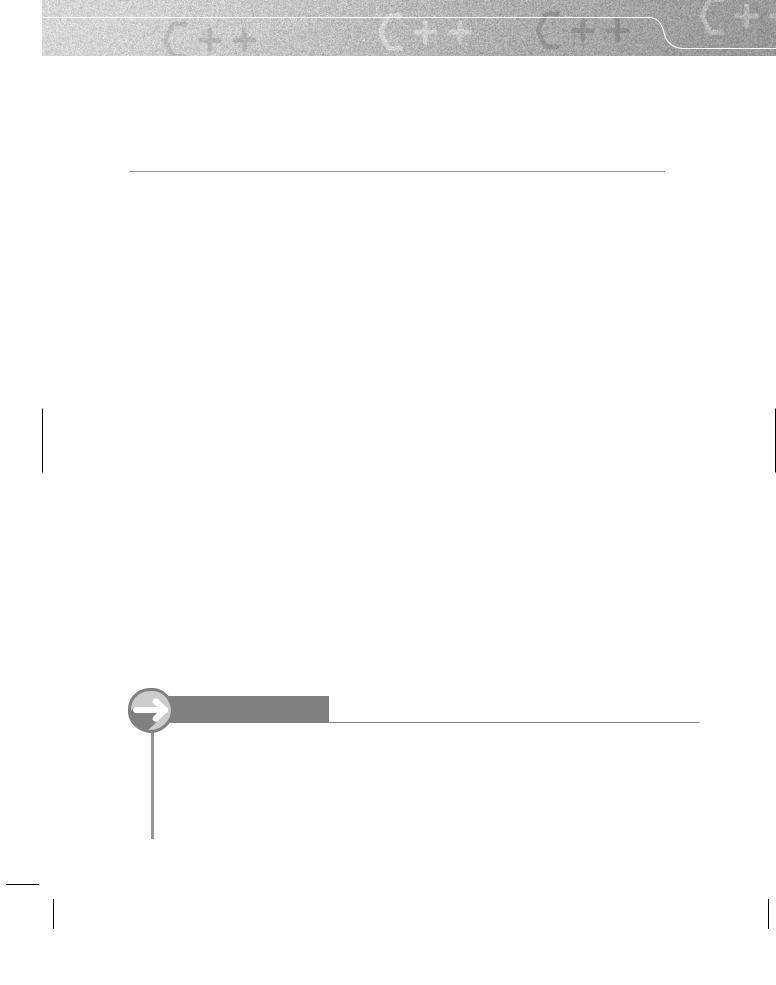
You Can Program In C++ (2006) [eng]
.pdf
48 |
CHAPTER 2 |
the incremented value. If placed after the variable it represents post-increment, i.e. the original value is used and the stored value is incremented. So:
int main( ){
int number(0);
std::cout << number++ << '\n'; // outputs 0 but changes number to 1 std::cout << ++number << '\n'; // further increments number to 2 and
// outputs 2
}
The symbol -- is used to represent preor post-decrement in the same way as ++ represents preor post-increment.
It is normal in C++ to prefer the use of pre-increment and pre-decrement to the post forms. It is usual (and safer) to avoid using these operators as part of more extensive expressions.
Logical
C++ provides six comparison operators:
Symbol |
Alternative |
Meaning |
||
|
token |
|
||
|
|
|
|
|
== |
|
|
|
true if the operands compare equal; otherwise false |
|
|
|
|
|
!= |
not eq |
false if the operands compare equal; otherwise true |
||
|
|
|
|
|
< |
|
|
|
true if the lhs is strictly less than the rhs; otherwise false |
|
|
|
|
|
<= |
|
|
|
true if the lhs is not more than the rhs; otherwise false |
|
|
|
|
|
> |
|
|
|
true if the lhs is strictly greater than the rhs; otherwise false |
|
|
|
|
|
>= |
|
|
|
true if the lhs is not less than the rhs; otherwise false |
|
|
|
|
|
There are also three Boolean operators whose use forces their operands to be treated as bool values. (Arithmetic and pointer values convert to bool on the basis that zero is false and all other values are true.)
Symbol |
Alternative token |
Meaning |
|
|
|
&& |
and |
true if both operands are true; false if either is false |
|
|
|
|| |
or |
true if either operand is true; false if both are false |
|
|
|
! |
not |
true if operand is false; false if operand is true |
|
|
|
In this book I will use the alternative tokens for the Boolean operators, because I find them clearer and less subject to confusion with the bitwise operators (see below)
The two binary Boolean operators use lazy evaluation. This means that the left-hand operand will always be evaluated first and the right-hand one will only be evaluated if necessary.
WARNING!
Lazy evaluation may lead to unexpected behavior. For example, if the left operand of and evaluates as false, the right operand will not be evaluated (and no side-effects of such possible evaluation will happen).

FUNDAMENTAL TYPES, OPERATORS, AND SIMPLE VARIABLES |
49 |
Bitwise
C++ provides six bitwise operators, i.e. operators that work on the individual bits of storage:
Operator |
Alternative |
Meaning |
|
token |
|
|
|
|
& |
bitand |
Sets a bit in the result to 1 if and only if both the corresponding bits |
|
|
in the operands are 1 |
|bitor Sets a bit in the result to 1 if and only if one or both of the
corresponding bits in the operands are 1
^ |
xor |
Sets a bits in the result to 1 if exactly one of the corresponding bits |
|
|
in the operands is 1 |
|
|
|
<< |
|
Shifts the bits of the left operand left by the number of places given |
|
|
by the right operand (as an unsigned integer value) |
|
|
|
>> |
|
Shifts the bits of the left operand right by the number of places |
|
|
given by the right operand (as an unsigned integer value) |
|
|
|
~ |
compl |
Inverts the values of all the bits in the single operand that follows |
|
|
|
WARNING!
Bitwise operators can be applied to any integer type, but applying them to signed integer types is usually a mistake and will frequently result in unexpected behavior. The shift operators are particularly vulnerable to inappropriate use of signed values for the left operand.
C++ reuses the shift operators as data-streaming operators when the left operand is some kind of data stream. That is by far the most common usage for the ‘shift’ operators in C++. Think of it as shifting data in and out.
The &, | and ^ operators are useful for doing masking operations for such things as graphics manipulations.
Compound assignment
In addition to the straightforward assignment operator (=) that stores the value of the right-hand operand in the object designated by the left-hand one, C++ provides ten compound operators. Each of the bitwise and arithmetic operators that take two operands (&, |, ^, <<, >>, +, -, *, /, and %) can be combined with an = to create a compound assignment.
The general rule for a compound assignment is that
obj op= expr;
is equivalent in behavior to:
obj = obj op expr;
Three of the compound assignment operators have alternative tokens (&= can be written as and eq, |= as or eq, and ^= as xor eq)

50 |
CHAPTER 2 |
Historically the compound assignment operators allowed programmers to tell primitive compilers that they wanted to use a hardware facility available on some machines to operate directly on memory. They are still widely used even though modern compilers do not need that kind of support. They allow the programmer to emphasize the direct modification of an object as opposed to the overwriting of one.
More on pointers
C++ not only allows programmers to access the machine addresses of objects (and functions), but also allows a certain number of operators to work with pointer values.
An integer value can be added to or subtracted from a data pointer. That will adjust the address by the amount necessary for locating a similar object that number of steps away from the base address. If ptr contains the address of an int then the value of ptr+2 will be the address of the second int on. It is up to the programmer to ensure that such an address is a valid address, of an object that belongs to the program. The increment and decrement operators (both preand post-) can be applied to pointers to adjust the values (addresses) they contain up or down to the next object of the relevant type.
You can also subtract a pointer from another of the same type. The answer will be the number of objects of that type from one to the other.
Preceding a variable by the & operator results in the address of the object that the variable refers
to.
Preceding a pointer value by the * operator provides direct access to the object whose address (pointer value) you have. So if i ptr contains the address of an object referred to by the variable i, *i ptr is another way to access the i object.
Any two pointers (either object or function pointers) of the same type can be compared for equality (==) or inequality (!=). Any two pointers whose values are addresses within the same object (such as an array) can be compared for order with <, <=, > and >=.
Note that idiomatic C++ source code makes much less use of pointer arithmetic than does C. Pointers are rare in high-level or application-level C++ code. Indeed pointers are never explicitly used or referred to in my earlier book, You Can Do It!, which demonstrates that much high-level programming can be done in C++ without them.
More on references
C++ provides a special mechanism for binding new names to existing objects. As names have types in C++ (unlike names in languages such as Python) and are always bound to a specific object (unlike the situation in Java, where a name has a type but can be used to refer to several different objects during the lifetime of the name), we need an extra type for names that do not have their own objects but use one provided from somewhere else.
Because reference-type names do not have their own objects there is no sense in allowing further derivation of types from a reference type. There are no objects of a reference type, only names. These names include an ‘empty’ temporary name used for returning objects from functions (called return by reference) as opposed to returning copies (called return by value).
Other operators
There are a number of other operators that we will come to later. Some of these are very specialized (such as sizeof, to determine the amount of memory that an object of a given type will occupy), and some are only appropriate to user-defined types (such as the dot and arrow operators). Some, such as the index and function operators, are surprising but have powerful uses in C++.

C H A P T E R 3
Looping and Making
Decisions
Looping (repeating some code several times, usually with some variable changing value) and decisionmaking are two of the most fundamental mechanisms of programming. We have used both in the earlier chapters, but we will look at the details and the alternatives in this chapter. I will also introduce you to the preferred C++ mechanisms for dealing with (text) strings and with contiguous arrays of objects of the same type. These mechanisms are different from those used in C and they are different to a greater or lesser extent from those used in many other popular languages.
A few readers whose previous experience of programming has been with pure functional languages may find the C++ mechanism for looping strange. They will have been used to using recursion to handle many of the places where repetition is desirable. Those who come from other procedural languages such as Visual Basic and Pascal will need to pay careful attention to the syntax used by C++ for both repetition and decision-making; it will be similar to what they are used to, but there will be important differences in the detail.
Some Library Types
std::string – a Library Type
In addition to the fundamental types that we looked at in the last chapter, C++ provides a number of types via the C++ Standard Library. We call these ‘user-defined types’, and I will eventually show you how to design and implement your own types. The important difference between using a fundamental type and using a Standard Library type (one of the major categories of user-defined type) is that the latter requires the inclusion of an appropriate header before we use it in source code.
std::string is one of these types and is the C++ way to handle a string – contiguous sequence – of characters used to represent some text. The Library (I will use ‘Library’ to mean ‘C++ Standard Library’) provides a lot of functionality for std::string. One of the most important aspects is that objects of type std::string adjust the size of the storage they use to meet the requirements of the text they are currently storing as a sequence of char. The growth (or reduction) in storage accommodates to the size of the text string.
Language Note: Code that uses std::string is more secure than the C use of an array of char, as it is less open to buffer-overrun exploits. This feature relieves the programmer of much of the work that the more primitive C mechanism requires. For those who come from other programming backgrounds there may be other surprises. For example, unlike the string mechanisms found in some other languages, C++ strings are mutable – that is, their contents can be changed (unless they have been declared as const).

52 |
CHAPTER 3 |
For the time being, we are going to limit ourselves to four properties of std::string objects:
1.They can be created in various ways, one of which is from a string literal. So we can write std::string greeting("Hello World");
to create a std::string object with the value "Hello World" for the variable greeting.
2.We can assign one string to another:
std::string message; // create an empty string message = greeting;
This results in message now containing its own copy of "Hello World".
3.We can extract a string from an input stream such as std::cin and store it in the object specified by a suitable variable:
std::cin >> message;
This will result in the object bound to message containing the next sequence of characters extracted from the console, starting with the first non-whitespace character and ending immediately before the next instance of whitespace. It leaves the terminal whitespace (remember, that includes newline characters) in std::cin’s input buffer. We will later see how to extract text that includes whitespace.
4.We can send a string to an output stream such as std::cout: std::cout << greeting << '\n';
This will result in ‘‘Hello World’’ being displayed on the console (and the output then moving to a new line).
std::vector<> – a Half Type
C++ has an interesting and very powerful mechanism for creating new types from existing ones: class templates. Writing useful templates takes a lot of experience, knowledge, and skill; using class templates designed by experts can make our lives much easier and is relatively trouble-free. std::vector<> is an example of a class template. It provides a way to create a sequence (or array) of objects. One important feature of std::vector<> objects is that they adjust to accommodate the number of objects currently contained. It also provides other useful functionality. C++ provides mechanisms for users to extend that functionality if they ever decide that there is something else that would be generally helpful.
I have called std::vector a half type because it needs something else before the result is a full C++ type. To create (instantiate) a type from a template we must provide other information such as, in the case of std::vector<>, the type of object it will contain.
T R Y T H I S
A well-chosen program is worth many pages of explanation; here is a small program for you to type in and try:
1 // numbers program created on 07/08/04 by FWG
2 #include <algorithm>
3 #include <exception>
4 #include <iostream>
5 #include <vector>
6

LOOPING AND MAKING DECISIONS |
53 |
7 int main( ){
8try{
9std::vector<int> numbers;
10do {
11std::cout << "Next whole number (-999 to stop): ";
12int next;
13std::cin >> next;
14if(next == -999) break;
15numbers.push_back(next);
16} while(true);
17if(numbers.size( ) == 0){
18std::cout << "There were no numbers input.\n";
19return 0; // exit program
20}
21std::sort(numbers.begin( ), numbers.end( ));
22std::cout << "Here are the " << numbers.size( )
23<< " numbers you typed in ascending numerical order:\n";
24for(int i(0); i != numbers.size( ); ++i){
25std::cout << numbers[i] << ", ";
26}
27std::cout << '\n';
28}
29catch(...){
30std::cerr << "***An exception was thrown.***\n";
31}
32}
I am going to delay the walkthrough of this program until after I have tackled the issues of looping and decisions in C++. You may feel that there are places where we could improve this program. For example, the program makes assumptions about the correctness of the input. Please be alert to such assumptions and get in the habit of dealing with them. I deliberately leave some of these problems in my code because I want you to check code rather than just taking my word for it. The above code together with the earlier programs supplies some context for the following.
Making Decisions
C++ provides three primary mechanisms for making decisions: if-else, switch, and a special operator that is usually referred to as the conditional or ternary operator (because it is the only C++ operator that takes three operands).
The if-else Statement
Not only do all major computer languages have a construct like this, but they also almost universally use the same words. However, please read on carefully, because there may be differences between C++ and the language you currently use.
Language Note: Python programmers need to be especially careful, because C++ does not use indentation as a syntactic element. Those used to languages such as Pascal will need to note that C++ restricts both if and else to controlling a single statement. This statement will often be a compound one created by placing one or more simple statements in a block defined by a matching pair of braces.

54 |
CHAPTER 3 |
The form of an if-else statement in C++ is:
if(Boolean-expression) action-one else action-two
In pseudocode, the if-else statement has this effect:
if Boolean-expression evaluates as true then action-one
else action-two
The Boolean expression can be anything that evaluates to a value that is implicitly convertible to a bool. That includes all the fundamental types and all pointer types. The value zero for any fundamental type is treated as false; all other values are treated as true. In the case of pointers, all values are treated as true except for a special value called the null pointer (a pointer that does not point to anything), which is treated as false (more about that when we deal with the details of pointers).
The actions have to be single statements. However, in C++, any group of statements enclosed in a pair of curly braces is a single compound statement. Simple statements in C++ are terminated with a ; (semicolon); however, a compound statement is terminated by the closing brace. Be careful that you do not add a semicolon after the closing brace of a compound statement (sometimes called a block statement), because that would constitute an empty simple statement, whose presence may be significant; for example,
{
a = 3; b = 4; c = 0;
};
comprises two statements at the outer level: a compound one, which itself consists of three statements, followed by an empty simple statement.
The else clause of if-else is optional (we have not used it in any program so far). However, it must be the next statement after the one controlled by the if. For example,
if(numbers.size( ) == 0) std::cout << "There were none.\n"; else std::cout << "There were " << numbers.size( ) << ".\n";
is fine, as is
if(numbers.size( ) == 0){
std::cout << "There were none.\n";
}
else std::cout << "There were " << numbers.size( ) << ".\n";
where I have written the single statement controlled by the if as a compound one. The following if-else statement is also OK:
if(numbers.size( ) == 0){
std::cout << "There were none.\n";
}
else {
std::cout << "There were " << numbers.size( ) << ".\n";
}
However, this one is not (see if you can spot the critical difference):
if(numbers.size( ) == 0){
std::cout << "There were none.\n";
};
else std::cout << "There were " << numbers.size( ) << ".\n";

LOOPING AND MAKING DECISIONS |
55 |
In this case the compiler may be able to diagnose the problem (the extra semicolon at the end of the compound statement), but in more complicated cases where there are ifs nested inside ifs, it may not be able to do so; instead it will misconstrue your intentions and the else part will not be considered as related to the immediately preceding if.
T R Y T H I S
Write a simple program that asks for an integer value and then outputs the simple message ‘zero’ if the value given was 0; otherwise it should output ‘not zero’.
The switch Statement
The if-else statement is for making two-way decisions, but sometimes we want to make a multi-way decision. By that, I mean that there are sometimes logically more than two choices. C++ provides the switch statement for this case. Here is the form of the switch statement:
switch(controlling-integer-expression){ |
|
||
case integer-value-one: action-one |
|
||
case integer-value-two: action-two |
|
||
etc. |
|
|
|
default: default-action |
|
|
|
} |
|
|
|
|
In pseudocode, the switch statement has this effect: |
||
if controlling-integer-expression evaluates as integer-value-one |
|||
then |
action-one, action-two, . . . , default-action |
(or until break or return is encountered) |
|
else if |
controlling-integer-expression |
evaluates as integer-value-two |
|
then |
action-two, . . . , default-action |
(or until |
break or return is encountered) |
else if |
etc. |
|
|
else default-action
There are a number of important details that need attention when using a C++ switch statement. The controlling expression must evaluate either to a value for some integer type or to a value that
is implicitly convertible to such a type. All the fundamental types conform to that requirement. However, pointers do not, as there is no automatic conversion from any pointer type to an integer type.
The case values must be fixed values known to the compiler. In general, that means that they should be literals for one of the fundamental integer types. Later we will see that there are a few other options.
The final default clause (actually, if you want to be eccentric, you can put it anywhere in the selection list) is optional, and if it is missing, the compiler will treat your code as if the default action is to do nothing.
The program will start executing the code from the corresponding case and continue until it encounters a return statement, a break statement, or the closing brace of the switch statement. It is important to understand this, because other languages with similar constructs treat the next case as terminating the current one.
Language Note: Pascal is an example of a language that uses a different design for its multi-way choice construct. The C++ feature (shared by other languages in the C family, such as Java) of allowing a case to fall through, i.e. executing the code for subsequent cases until something explicitly stops the sequential execution, is a cause of bugs in programs, so you need to be careful when using a switch statement and avoid simply treating it as the C++ equivalent of a mechanism you already use in some other language.

56 |
CHAPTER 3 |
Here is a short code fragment to demonstrate the use of a switch statement:
int i(0); std::cin >> i; switch(i) {
case 0:
std::cout << "Cannot divide by zero.\n"; break;
case 1:
std::cout << "Dividing by 1 does not change anything.\n"; break;
default:
std::cout << 100/i << '\n';
}
T R Y T H I S
Write a short program to use the above fragment, and check the consequences of leaving out one of the break statements. Do not forget to add input validation to your program.
switch Continued
Here is a second code fragment that uses a switch statement:
char c(0); std::cin >> c; switch(c) {
case 'a': case 'e': case 'i': case 'o': case 'u':
std::cout << c << " is a vowel.\n"; break;
case 'y':
std::cout << "'y' is a vowel in some contexts.\n"; break;
default:
std::cout << c << " is not a vowel.\n";
}
Note how the C++ case mechanism allows a piece of code to deal with several cases. Some languages deal with this in a different way, but C++ uses the C mechanism (so that more C code will compile as C++).
T R Y T H I S
Write a program using the above code. Now improve it to deal with uppercase letters. We need to do more work to sort out the consonants from the other possible inputs. Accented letters

LOOPING AND MAKING DECISIONS |
57 |
add even more work. If you want to experiment further, the <cctype> header provides a number of functions from the Standard C Library that allow you to classify chars. These include std::isdigit( ), std::ispunct( ), and std::isalpha( ). Those functions return true if the character represents a digit, a punctuation symbol, or a letter respectively. For more details and for details of locale-dependent alternatives (taking account of national character sets), see a good library reference such as The C++ Standard Library by Nicolai Josuttis [Josuttis 1999].
The Conditional Operator
C++ provides an operator that allows you to select which of two alternative expressions to evaluate depending on the Boolean value of a controlling expression. As this is an operator, there will be a resulting value when it is used. It is the presence of a value that distinguishes the conditional operator from the if-else construct. Here is the form of the conditional operator:
Boolean-control-expression ? result-expression-one : result-expression-two
The conditional operator is one of several C++ operators that consist of two symbols that are separated from each other. In this case, the symbols are ? and :. The control expression is evaluated first to determine which of the two result expressions should then be evaluated. If the control expression evaluates as true, the value of the overall expression is the result of evaluating the first result expression. If it evaluates as false, the value of the overall expression is the value of the second result expression. If there are side effects from the evaluations, only those for evaluating the control expression and the appropriate choice of the result expressions will occur.
Language Note: C programmers should be particularly careful, because C++ has extended the potential use of this operator, so that, for example:
i < j ? i = 0 : j = 0;
compiles and works (it sets the smaller of i and j to zero). More controversially, the following compiles in C++:
(i < j ? i : j) = 0;
In other words, where both the alternatives provide objects of the same type (presumably int in this case), a conditional expression in parentheses can appear on the left of an assignment. It is generally a poor idea to use this facility.
Here is a small snippet of code demonstrating a simple use of the conditional operator (it assumes that count is a number of oranges):
std::cout << "There " << ((count == 1) ? "is" : "are" ) << count << " orange" << ((count != 1) ? "s" : "") << ".\n";
It deals with providing the correct version for a single object. It even deals with that quirk of English that treats zero objects as plural. (Note that the operator-precedence rules make the parentheses around count == 1 and count != 1 redundant. I have used the parentheses to assist your reading of the statements.)
T R Y T H I S
Go back to the numbers program (page 52) and:
1.change the if statement that includes an exit by return 0 to an if-else statement to handle the two cases as alternatives;
2.change the output statement to deal with the case where the user inputs only one value before ending with −999.
